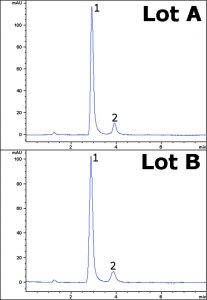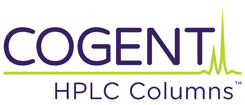Isocratic Separation of Isomers
In this easy isocratic method, the cis and trans isomers of Resveratrol are separated using a near-UHPLC stationary phase. The Cogent Bidentate C18 2.o™ Column produces excellent efficiency for both analyte peaks. The sample used here is an actual capsule formulation, demonstrating the suitability of the column for real-world samples. With a more sophisticated detection methods such as LC-MS, the method could be applied to complex samples where Resveratrol may be present, such as red wine.
Below data is collected from two different stationary phase lots ( A and B ) to demonstrate reproducibility of the material.


Peaks:
1. trans-Resveratrol
2. cis-Resveratrol
Method Conditions
Column: Cogent Bidentate C18 2.o™, 2.2μm, 120Å
Catalog No.: 40218-05P-2
Dimensions: 2.1 x 50 mm
Mobile Phase: 75% DI Water / 25% Acetonitrile / 0.1% Formic Acid
Injection vol.: 0.2μL
Flow rate: 0.2mL / minute
Detection: UV @ 308nm
Sample: 100mg strength Resveratrol capsule contents were added to a 100 mL volumetric flask containing a portion of 50/50/0.1 DI Water / Acetonitrile / Formic Acid. Solution was then sonicated for 10 minutes and diluted to mark. After mixing, a portion was filtered with a 0.45μm Nylon Syringe Filter (MicroSolv Tech. Corp.)
t0: 1.2 minutes
Note: Resveratrol is a natural product found in the skin of red grapes and other sources. It has been reported to have anti-cancer, anti-aging, cardio-protective, and anti-diabetic effects.
Attachment
No 330 Resveratrol Isomer Separation pdf 0.4 Mb Download File


